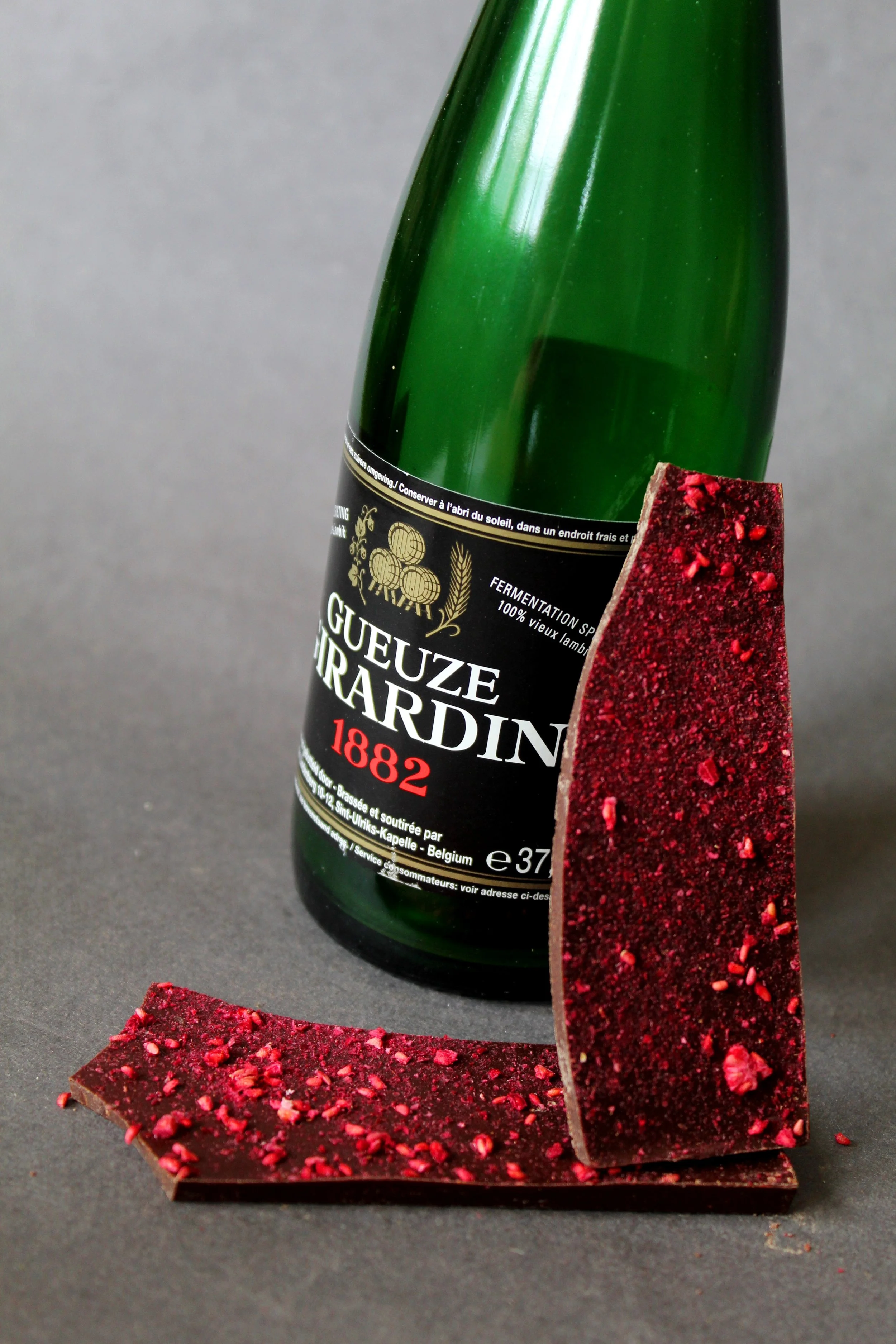Pairings Gueuze and Wild Ales with Craft Chocolate
At the rustic fringes of the beer world, where the field grass grows long and the edges are left wild, there are beers that explore the character of fermentation as it once was, before it was tamed by modern brewing technology and controls. Beers like the Lambics and Gueuzes of Belgium, as well as a variety of American beers—some homages to those Belgian traditions, some unique creations in no established mold—show a wide range of expressions that highlight the complexity of wild fermentations.
In conventional beer, a brewer pitches a specific, pre-selected yeast strain from one of two species into a sterile wort. The results of this fermentation are relatively predictable, and may be more or less expressive depending on the chosen yeast and details of the fermentation controls.
In wild or spontaneously fermented beer styles like the ones we’re talking about here, brewers either pitch a mixed culture of various yeast and bacteria species into the beer, or simply allow the ambient microorganisms in the environment of the brewery and the wooden vessels the beer is put into to inoculate the beer and begin their complex fermentation. This is beer at its most primitive, its least controlled. Think of these as the natural wines of the beer world.
These beers occupy a small niche in the broader beer ecosystem, and they’re almost never big sellers. However, they can be among the most coveted and esteemed small-release beers in a brewery’s lineup, and—thankfully for us—they can pair beautifully with craft chocolate. Pairing with these beers can be challenging, but they offer some truly elegant and eye-opening pairings.
Description—While technically “wild” does not equal “sour” in all cases, the beers we’re talking about here are generally quite sour and acidic. Along side this acidity there are complex and sometimes unexpected fermentation flavors that sometimes get lumped under the indefinite euphemism “funky.” General what this refers to are earthy, agrarian aromas like hay, horse blanket (an overused, sometimes misunderstood term that is nonetheless accurate in some cases), soil, and others. Like bold blue cheeses, these beers can be both challenging and elegant.
Examples—Great Gueuzes can be found in the product ranges offered by Boon, Drie Fonteinen, Cantillon, Girardin, and Lindeman’s in Belgium, among others. Excellent American wild ales can be found from Allagash, Jester King, Little Fish, Anchorage, Jolly Pumpkin, Russian River, Oxbow, and many others.
Pairing with Chocolate—The complexity and unusual flavors of these beers offer pairing opportunities few others styles provide. These beers offer some of the only pairing options for bars with mushrooms or earthy herb inclusions. Dark bars with dehydrated fruit inclusions can be amazing here. These beers can also handle more acidic single origin bars as well.
Avoid When Pairing—”Chocolatey” single origin bars, anything creamy or milky, and bars with spice inclusions.
First Example Pairing—Gueuze Girardin 1882 (black label) from Belgium is one of my favorite Oude Gueuzes, with an array of pinky-in-the-air tasting notes, including diesel, wet stone, apple leaves, hay, and ragweed (though let’s be honest: when we’re getting this into the weeds, everyone is finding and naming their own experiences, so your mileage will likely vary). It’s difficult to talk about these beers without sounding like you’re trying too hard, but they are truly fascinating.
Paired with Ritual’s elegant The Aprés Bar, a 70% dark chocolate made with champagne-soaked nibs and freeze-dried raspberries, most of the beer’s rusticity is smoothed away, leaving a gentle earthiness supporting the raspberries, brought fully to life by the beer’s acidity.
Second Example Pairing—Branch & Bone L’Internationale from Ohio was a Bière de Garde brewed a few years back with raw wheat and aged hops, and was fermented with their house mixed culture. Funky notes of a musty attic meet gentle apricot and cherry with moderate acidity and a touch of hay and light, grassy bitterness.
A pairing with Somerville’s Chuncho Peru 75% dark chocolate bar made with chaga mushrooms rounded the rough edges of both beer and bar, yielding ripe peach flesh and sweet chanterelle mushroom with just a touch of surprising strawberry and a crisp, acidic finish. Gorgeous.
Go Exploring
Gueuzes and wild ales can be an acquired taste, which just means they take some curiosity to get past the initial surprise of their flavors. They don’t taste how we’re trained to expect beer to taste. On the other side of that initial step of faith however is a world of complex and evocative flavors, and those flavors can pair with chocolate bars we’d never expect. Go exploring.

